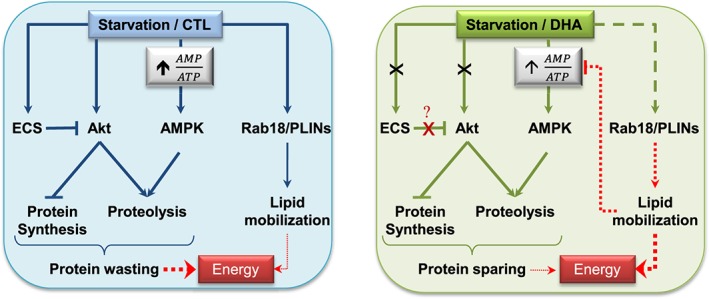Figure 9.

Schematic model of the effects of docosahexaenoic acid on muscle protein turnover and lipid mobilization during 48 h fasting. Left panel: Akt‐ and adenosine monophosphate‐activated protein kinase‐dependent signalling pathways are down and up‐regulated by fasting, respectively, resulting in reduced protein synthesis and enhanced proteolysis. The endocannabinoid system can inactivate the Akt‐dependent signalling pathway (22, 23), and is also induced in fasting. Finally, fasting also induced lipid droplet markers (Rab18 and PLINs expression), providing cells with energy through lipid mobilization. Right panel: docosahexaenoic acid (i) preserved Akt activity and blocked the activation of the endocannabinoid system during fasting. Whether the effect of docosahexaenoic acid on Akt activity during fasting is direct or indirect via the endocannabinoid system remains to be elucidated. Furthermore, docosahexaenoic acid had (ii) no effect on markers of protein synthesis, but (iii) partially prevented adenosine monophosphate‐activated protein kinase and proteolysis activation, and iv) modulated the overexpression of lipid droplet markers. The latter changes may modify the subpopulations of lipid droplets and therefore influence lipid mobilization (34, 38–40). This scheme suggests that docosahexaenoic acid changed either the nature of intracellular lipids and/or improve lipid mobilization efficiency, resulting in subsequent muscle protein sparing. Arrows indicate positive inputs whereas lines ending with a cross bar indicate inhibitory inputs. The docosahexaenoic acid effect is indicated in green lines vs. standard conditions in blue lines. Crosses indicate that docosahexaenoic acid blocked the fasting effect. Finally, dashed green line indicates that docosahexaenoic acid modified the fasting effect. Thick or thin lines denote strong or slight effects, respectively. Effects represented by dotted lines remain to be demonstrated.
